Visitor Attraction Management Report: Economic and Social Effects
VerifiedAdded on 2021/02/20
|12
|3442
|27
Report
AI Summary
This report delves into visitor attraction management, focusing on the London and Partners promotional agency. It explores the classification of visitor attractions, examining natural, built, and developed-for-another-purpose categories. The report analyzes the importance of visitor attractions, particularly the Epping Forest, London Eye, and the Victoria and Albert Museum, and their impact on economic growth, including foreign earnings, employment, and cultural exchange. It further investigates the needs and motivations of different visitor types, such as demographic and psychographic segments, adventure tourists, and business tourists. The report also discusses the positive and negative social, cultural, economic, and environmental impacts of visitor attraction tourism, providing examples. Finally, it includes a feasibility study assessing market demand, competition, product development, and financial viability, as well as an assessment of visitor management strategies for sustainable development.
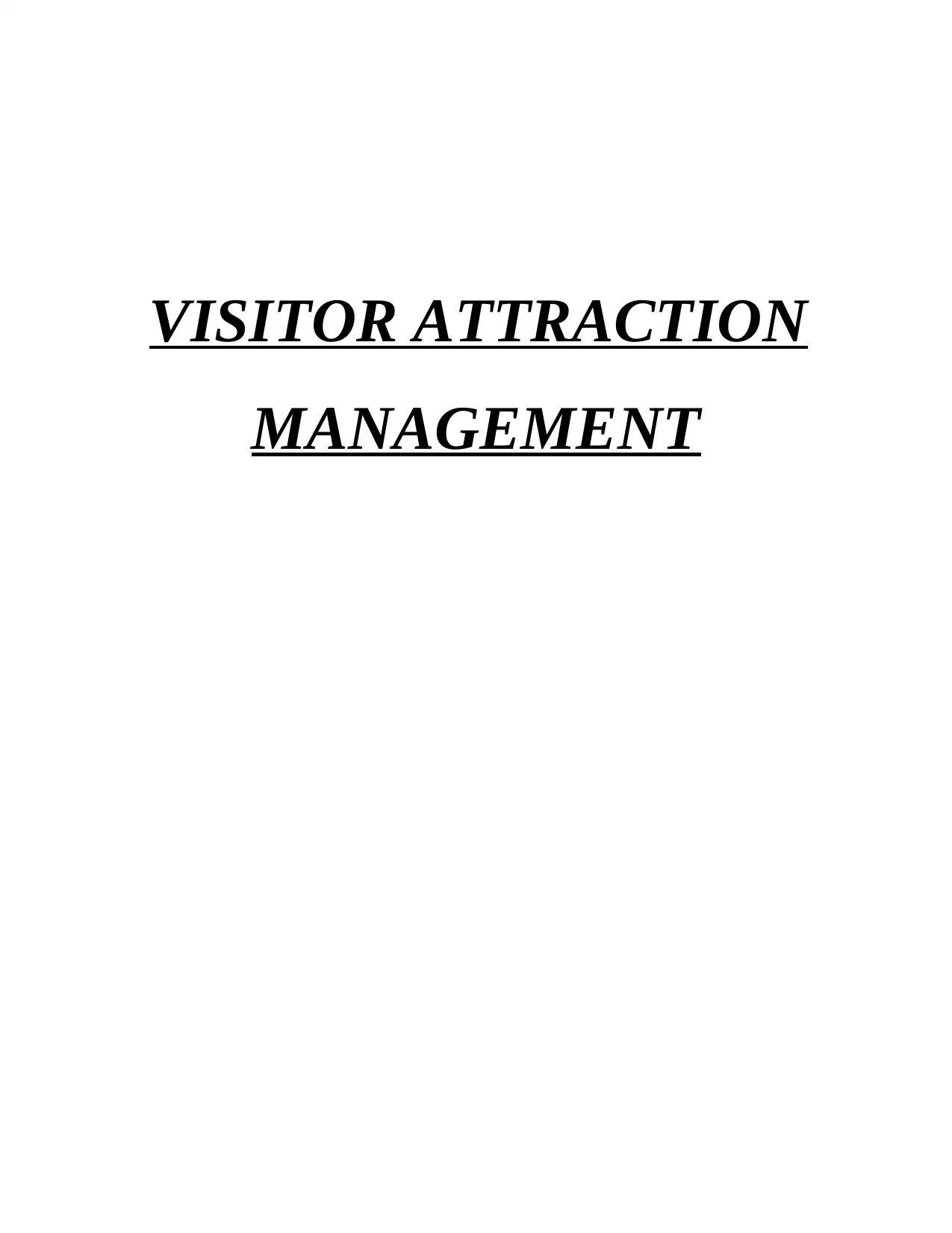
VISITOR ATTRACTION
MANAGEMENT
MANAGEMENT
Paraphrase This Document
Need a fresh take? Get an instant paraphrase of this document with our AI Paraphraser
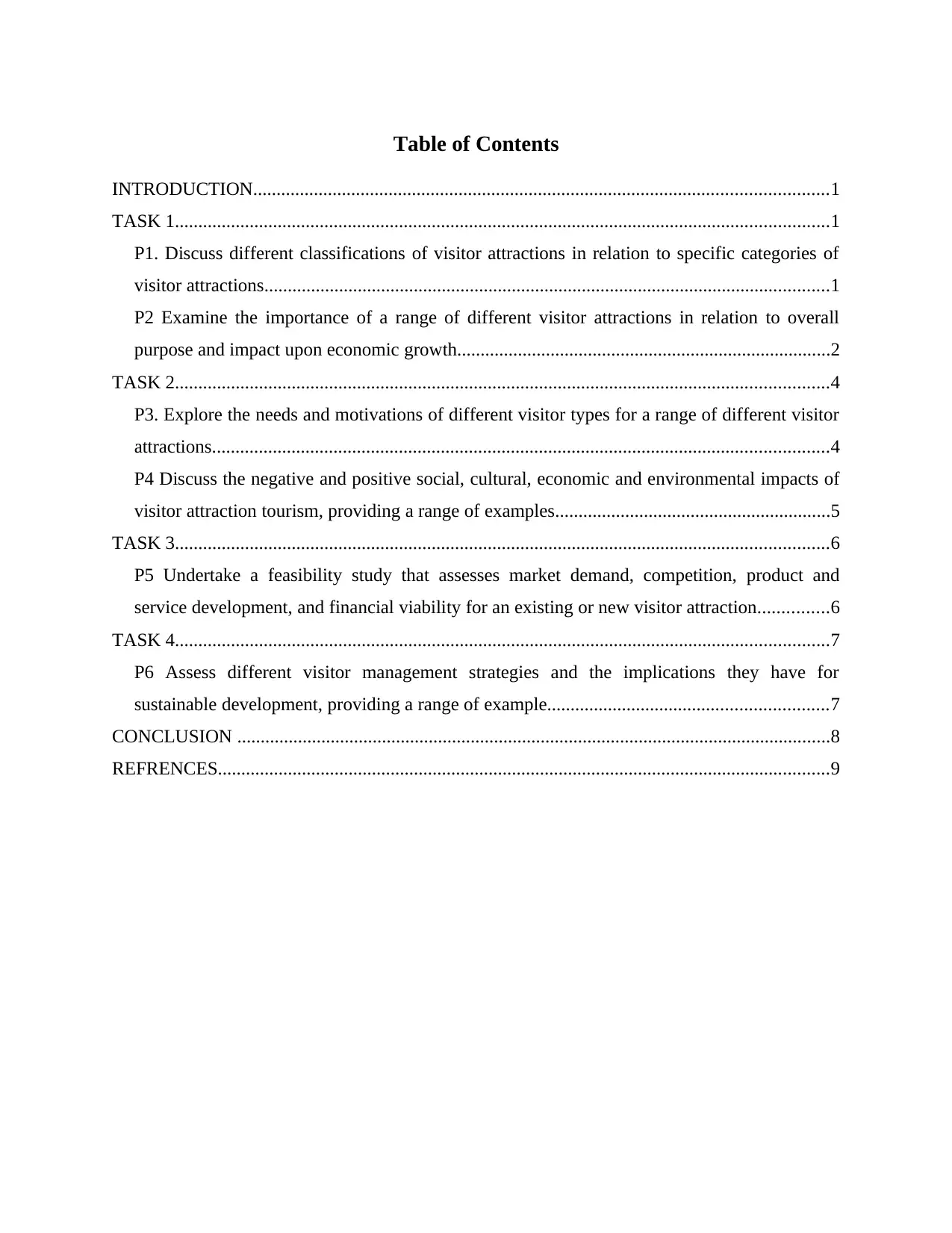
Table of Contents
INTRODUCTION...........................................................................................................................1
TASK 1............................................................................................................................................1
P1. Discuss different classifications of visitor attractions in relation to specific categories of
visitor attractions.........................................................................................................................1
P2 Examine the importance of a range of different visitor attractions in relation to overall
purpose and impact upon economic growth................................................................................2
TASK 2............................................................................................................................................4
P3. Explore the needs and motivations of different visitor types for a range of different visitor
attractions....................................................................................................................................4
P4 Discuss the negative and positive social, cultural, economic and environmental impacts of
visitor attraction tourism, providing a range of examples...........................................................5
TASK 3............................................................................................................................................6
P5 Undertake a feasibility study that assesses market demand, competition, product and
service development, and financial viability for an existing or new visitor attraction...............6
TASK 4............................................................................................................................................7
P6 Assess different visitor management strategies and the implications they have for
sustainable development, providing a range of example............................................................7
CONCLUSION ...............................................................................................................................8
REFRENCES...................................................................................................................................9
INTRODUCTION...........................................................................................................................1
TASK 1............................................................................................................................................1
P1. Discuss different classifications of visitor attractions in relation to specific categories of
visitor attractions.........................................................................................................................1
P2 Examine the importance of a range of different visitor attractions in relation to overall
purpose and impact upon economic growth................................................................................2
TASK 2............................................................................................................................................4
P3. Explore the needs and motivations of different visitor types for a range of different visitor
attractions....................................................................................................................................4
P4 Discuss the negative and positive social, cultural, economic and environmental impacts of
visitor attraction tourism, providing a range of examples...........................................................5
TASK 3............................................................................................................................................6
P5 Undertake a feasibility study that assesses market demand, competition, product and
service development, and financial viability for an existing or new visitor attraction...............6
TASK 4............................................................................................................................................7
P6 Assess different visitor management strategies and the implications they have for
sustainable development, providing a range of example............................................................7
CONCLUSION ...............................................................................................................................8
REFRENCES...................................................................................................................................9
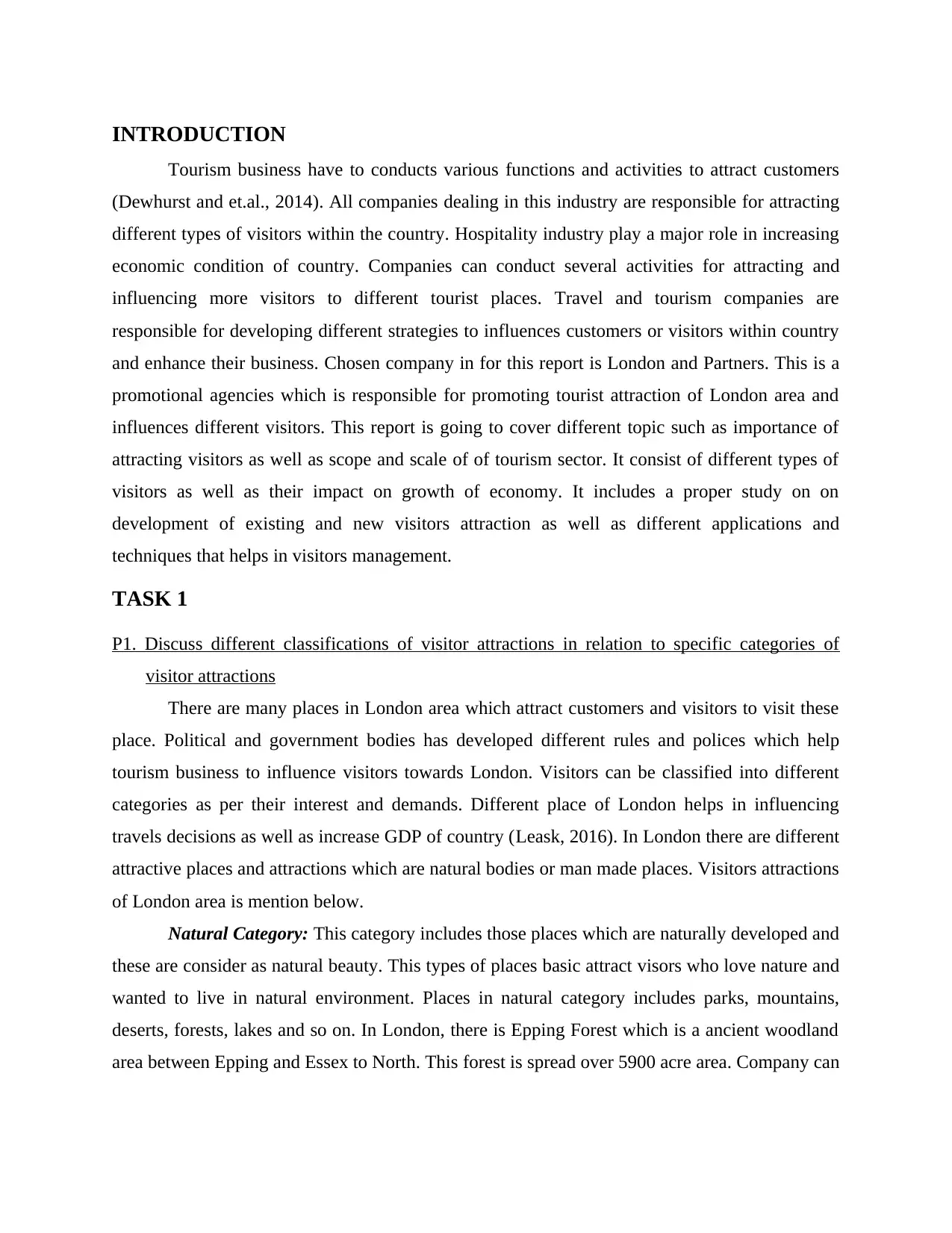
INTRODUCTION
Tourism business have to conducts various functions and activities to attract customers
(Dewhurst and et.al., 2014). All companies dealing in this industry are responsible for attracting
different types of visitors within the country. Hospitality industry play a major role in increasing
economic condition of country. Companies can conduct several activities for attracting and
influencing more visitors to different tourist places. Travel and tourism companies are
responsible for developing different strategies to influences customers or visitors within country
and enhance their business. Chosen company in for this report is London and Partners. This is a
promotional agencies which is responsible for promoting tourist attraction of London area and
influences different visitors. This report is going to cover different topic such as importance of
attracting visitors as well as scope and scale of of tourism sector. It consist of different types of
visitors as well as their impact on growth of economy. It includes a proper study on on
development of existing and new visitors attraction as well as different applications and
techniques that helps in visitors management.
TASK 1
P1. Discuss different classifications of visitor attractions in relation to specific categories of
visitor attractions
There are many places in London area which attract customers and visitors to visit these
place. Political and government bodies has developed different rules and polices which help
tourism business to influence visitors towards London. Visitors can be classified into different
categories as per their interest and demands. Different place of London helps in influencing
travels decisions as well as increase GDP of country (Leask, 2016). In London there are different
attractive places and attractions which are natural bodies or man made places. Visitors attractions
of London area is mention below.
Natural Category: This category includes those places which are naturally developed and
these are consider as natural beauty. This types of places basic attract visors who love nature and
wanted to live in natural environment. Places in natural category includes parks, mountains,
deserts, forests, lakes and so on. In London, there is Epping Forest which is a ancient woodland
area between Epping and Essex to North. This forest is spread over 5900 acre area. Company can
Tourism business have to conducts various functions and activities to attract customers
(Dewhurst and et.al., 2014). All companies dealing in this industry are responsible for attracting
different types of visitors within the country. Hospitality industry play a major role in increasing
economic condition of country. Companies can conduct several activities for attracting and
influencing more visitors to different tourist places. Travel and tourism companies are
responsible for developing different strategies to influences customers or visitors within country
and enhance their business. Chosen company in for this report is London and Partners. This is a
promotional agencies which is responsible for promoting tourist attraction of London area and
influences different visitors. This report is going to cover different topic such as importance of
attracting visitors as well as scope and scale of of tourism sector. It consist of different types of
visitors as well as their impact on growth of economy. It includes a proper study on on
development of existing and new visitors attraction as well as different applications and
techniques that helps in visitors management.
TASK 1
P1. Discuss different classifications of visitor attractions in relation to specific categories of
visitor attractions
There are many places in London area which attract customers and visitors to visit these
place. Political and government bodies has developed different rules and polices which help
tourism business to influence visitors towards London. Visitors can be classified into different
categories as per their interest and demands. Different place of London helps in influencing
travels decisions as well as increase GDP of country (Leask, 2016). In London there are different
attractive places and attractions which are natural bodies or man made places. Visitors attractions
of London area is mention below.
Natural Category: This category includes those places which are naturally developed and
these are consider as natural beauty. This types of places basic attract visors who love nature and
wanted to live in natural environment. Places in natural category includes parks, mountains,
deserts, forests, lakes and so on. In London, there is Epping Forest which is a ancient woodland
area between Epping and Essex to North. This forest is spread over 5900 acre area. Company can
⊘ This is a preview!⊘
Do you want full access?
Subscribe today to unlock all pages.

Trusted by 1+ million students worldwide
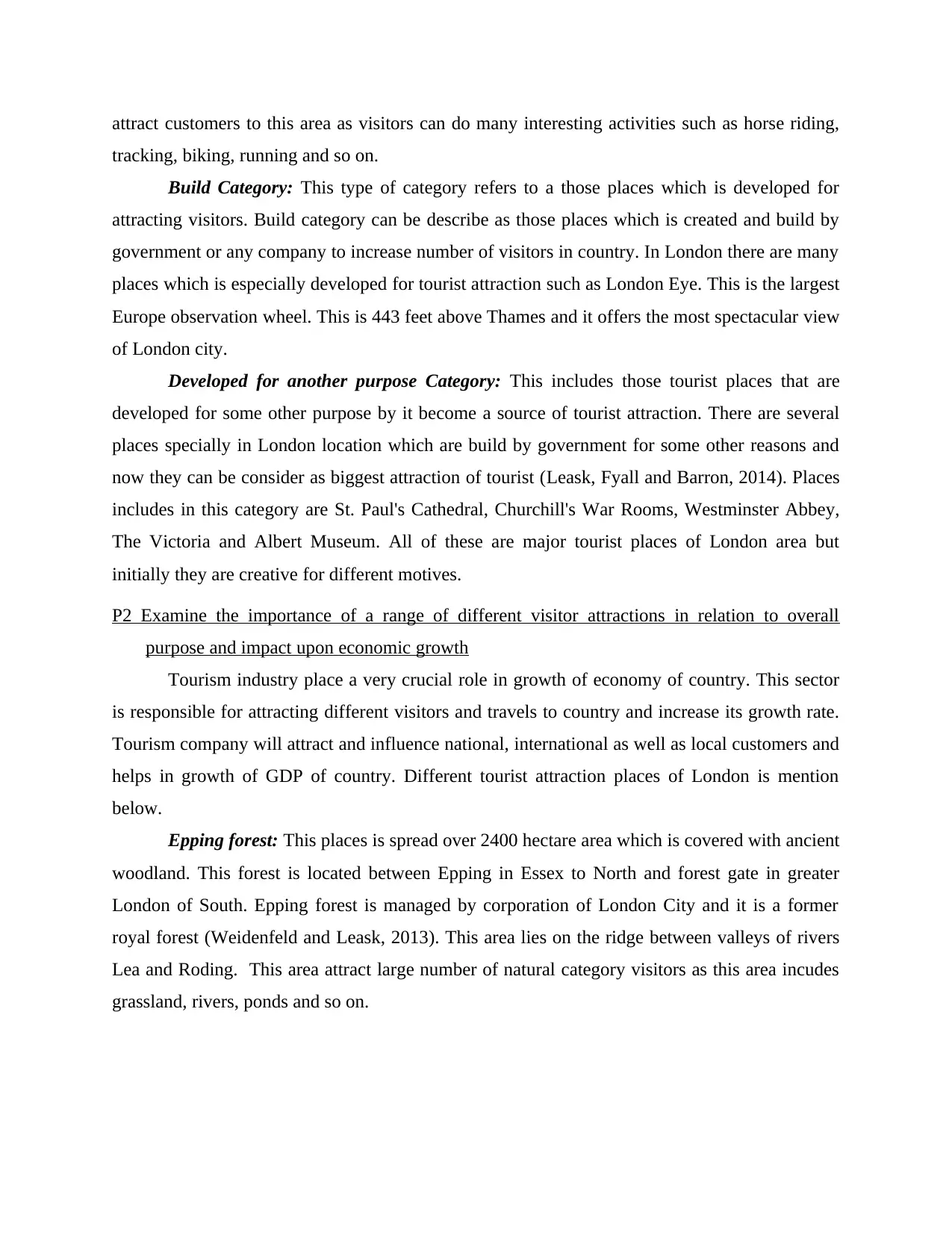
attract customers to this area as visitors can do many interesting activities such as horse riding,
tracking, biking, running and so on.
Build Category: This type of category refers to a those places which is developed for
attracting visitors. Build category can be describe as those places which is created and build by
government or any company to increase number of visitors in country. In London there are many
places which is especially developed for tourist attraction such as London Eye. This is the largest
Europe observation wheel. This is 443 feet above Thames and it offers the most spectacular view
of London city.
Developed for another purpose Category: This includes those tourist places that are
developed for some other purpose by it become a source of tourist attraction. There are several
places specially in London location which are build by government for some other reasons and
now they can be consider as biggest attraction of tourist (Leask, Fyall and Barron, 2014). Places
includes in this category are St. Paul's Cathedral, Churchill's War Rooms, Westminster Abbey,
The Victoria and Albert Museum. All of these are major tourist places of London area but
initially they are creative for different motives.
P2 Examine the importance of a range of different visitor attractions in relation to overall
purpose and impact upon economic growth
Tourism industry place a very crucial role in growth of economy of country. This sector
is responsible for attracting different visitors and travels to country and increase its growth rate.
Tourism company will attract and influence national, international as well as local customers and
helps in growth of GDP of country. Different tourist attraction places of London is mention
below.
Epping forest: This places is spread over 2400 hectare area which is covered with ancient
woodland. This forest is located between Epping in Essex to North and forest gate in greater
London of South. Epping forest is managed by corporation of London City and it is a former
royal forest (Weidenfeld and Leask, 2013). This area lies on the ridge between valleys of rivers
Lea and Roding. This area attract large number of natural category visitors as this area incudes
grassland, rivers, ponds and so on.
tracking, biking, running and so on.
Build Category: This type of category refers to a those places which is developed for
attracting visitors. Build category can be describe as those places which is created and build by
government or any company to increase number of visitors in country. In London there are many
places which is especially developed for tourist attraction such as London Eye. This is the largest
Europe observation wheel. This is 443 feet above Thames and it offers the most spectacular view
of London city.
Developed for another purpose Category: This includes those tourist places that are
developed for some other purpose by it become a source of tourist attraction. There are several
places specially in London location which are build by government for some other reasons and
now they can be consider as biggest attraction of tourist (Leask, Fyall and Barron, 2014). Places
includes in this category are St. Paul's Cathedral, Churchill's War Rooms, Westminster Abbey,
The Victoria and Albert Museum. All of these are major tourist places of London area but
initially they are creative for different motives.
P2 Examine the importance of a range of different visitor attractions in relation to overall
purpose and impact upon economic growth
Tourism industry place a very crucial role in growth of economy of country. This sector
is responsible for attracting different visitors and travels to country and increase its growth rate.
Tourism company will attract and influence national, international as well as local customers and
helps in growth of GDP of country. Different tourist attraction places of London is mention
below.
Epping forest: This places is spread over 2400 hectare area which is covered with ancient
woodland. This forest is located between Epping in Essex to North and forest gate in greater
London of South. Epping forest is managed by corporation of London City and it is a former
royal forest (Weidenfeld and Leask, 2013). This area lies on the ridge between valleys of rivers
Lea and Roding. This area attract large number of natural category visitors as this area incudes
grassland, rivers, ponds and so on.
Paraphrase This Document
Need a fresh take? Get an instant paraphrase of this document with our AI Paraphraser
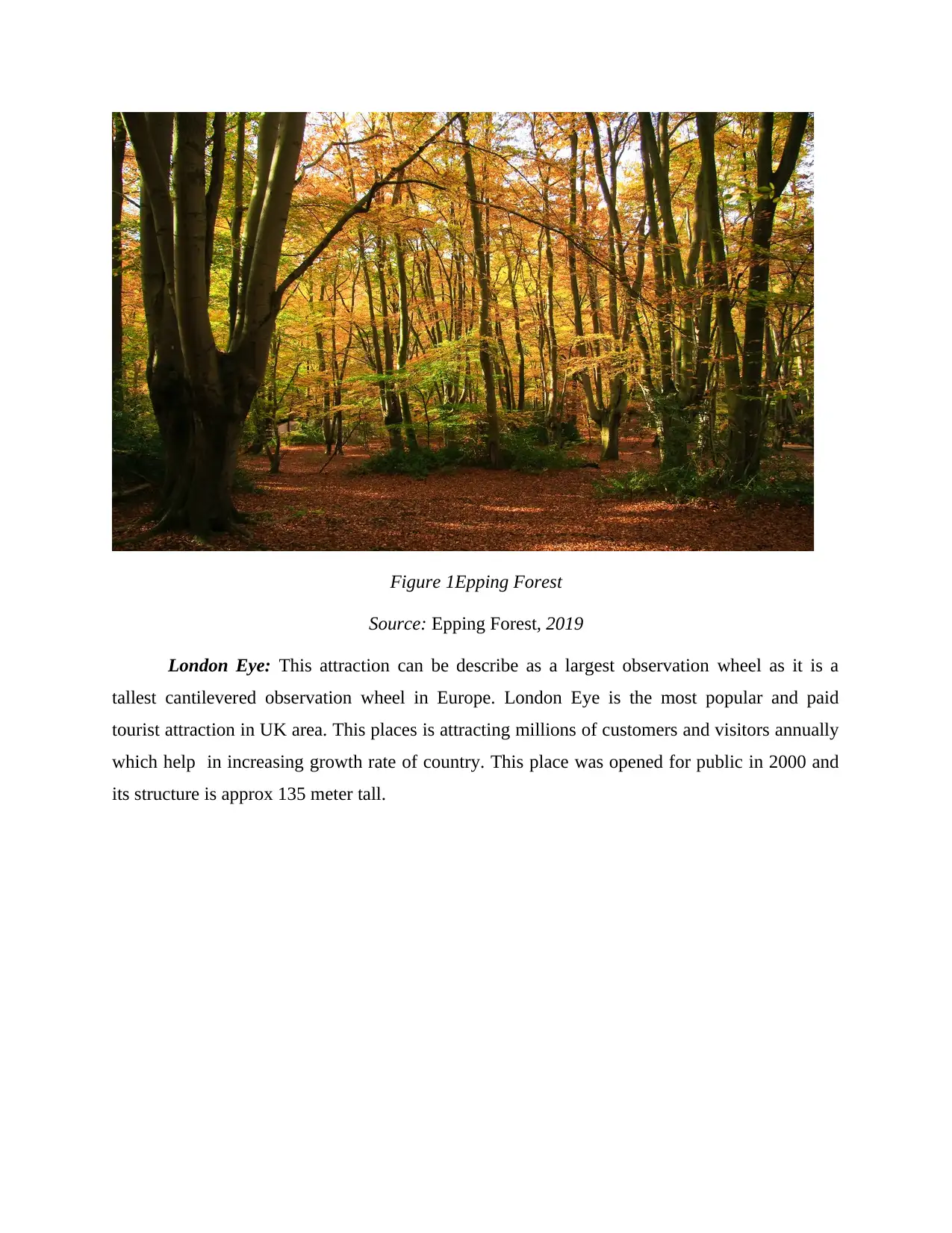
Figure 1Epping Forest
Source: Epping Forest, 2019
London Eye: This attraction can be describe as a largest observation wheel as it is a
tallest cantilevered observation wheel in Europe. London Eye is the most popular and paid
tourist attraction in UK area. This places is attracting millions of customers and visitors annually
which help in increasing growth rate of country. This place was opened for public in 2000 and
its structure is approx 135 meter tall.
Source: Epping Forest, 2019
London Eye: This attraction can be describe as a largest observation wheel as it is a
tallest cantilevered observation wheel in Europe. London Eye is the most popular and paid
tourist attraction in UK area. This places is attracting millions of customers and visitors annually
which help in increasing growth rate of country. This place was opened for public in 2000 and
its structure is approx 135 meter tall.
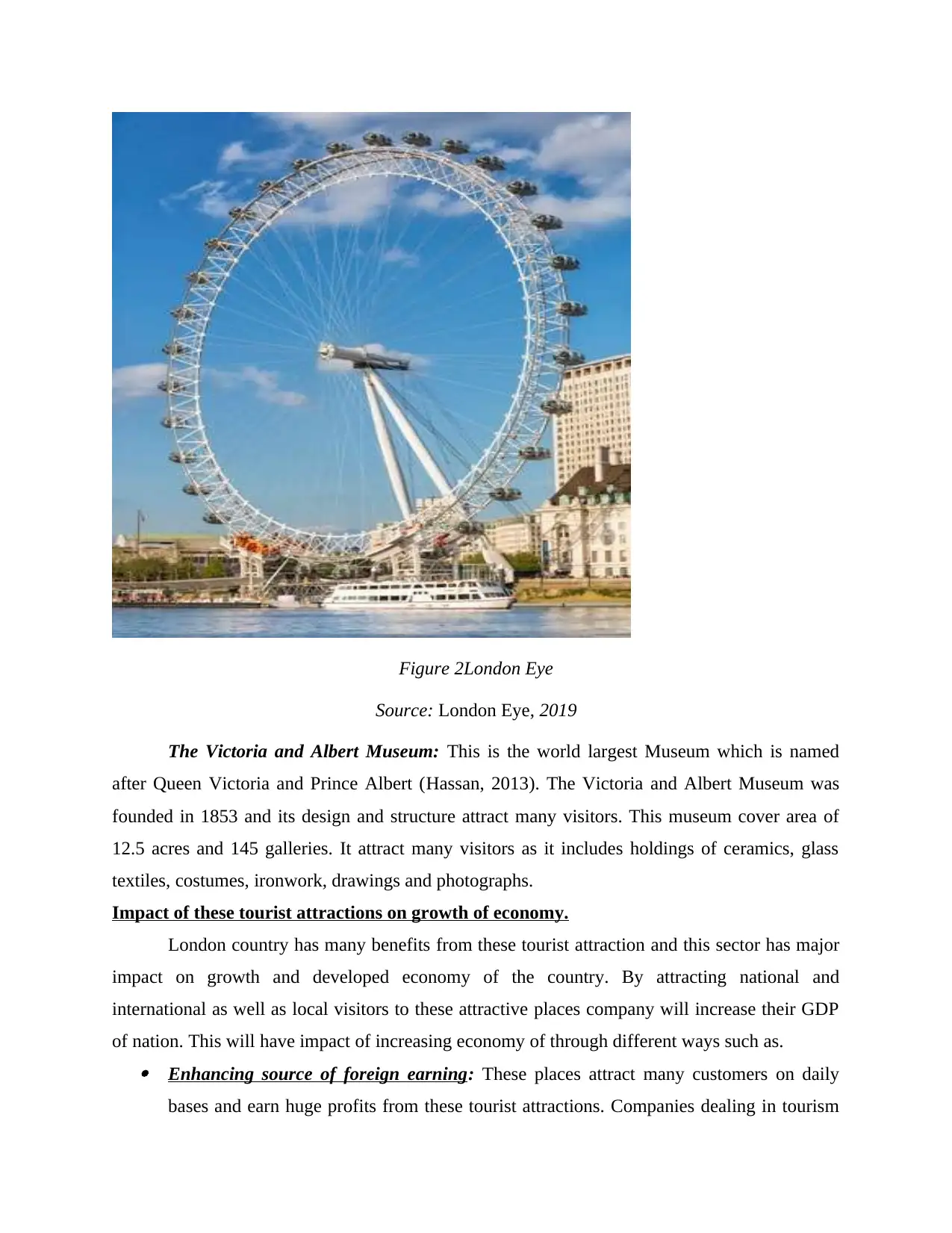
Figure 2London Eye
Source: London Eye, 2019
The Victoria and Albert Museum: This is the world largest Museum which is named
after Queen Victoria and Prince Albert (Hassan, 2013). The Victoria and Albert Museum was
founded in 1853 and its design and structure attract many visitors. This museum cover area of
12.5 acres and 145 galleries. It attract many visitors as it includes holdings of ceramics, glass
textiles, costumes, ironwork, drawings and photographs.
Impact of these tourist attractions on growth of economy.
London country has many benefits from these tourist attraction and this sector has major
impact on growth and developed economy of the country. By attracting national and
international as well as local visitors to these attractive places company will increase their GDP
of nation. This will have impact of increasing economy of through different ways such as. Enhancing source of foreign earning: These places attract many customers on daily
bases and earn huge profits from these tourist attractions. Companies dealing in tourism
Source: London Eye, 2019
The Victoria and Albert Museum: This is the world largest Museum which is named
after Queen Victoria and Prince Albert (Hassan, 2013). The Victoria and Albert Museum was
founded in 1853 and its design and structure attract many visitors. This museum cover area of
12.5 acres and 145 galleries. It attract many visitors as it includes holdings of ceramics, glass
textiles, costumes, ironwork, drawings and photographs.
Impact of these tourist attractions on growth of economy.
London country has many benefits from these tourist attraction and this sector has major
impact on growth and developed economy of the country. By attracting national and
international as well as local visitors to these attractive places company will increase their GDP
of nation. This will have impact of increasing economy of through different ways such as. Enhancing source of foreign earning: These places attract many customers on daily
bases and earn huge profits from these tourist attractions. Companies dealing in tourism
⊘ This is a preview!⊘
Do you want full access?
Subscribe today to unlock all pages.

Trusted by 1+ million students worldwide
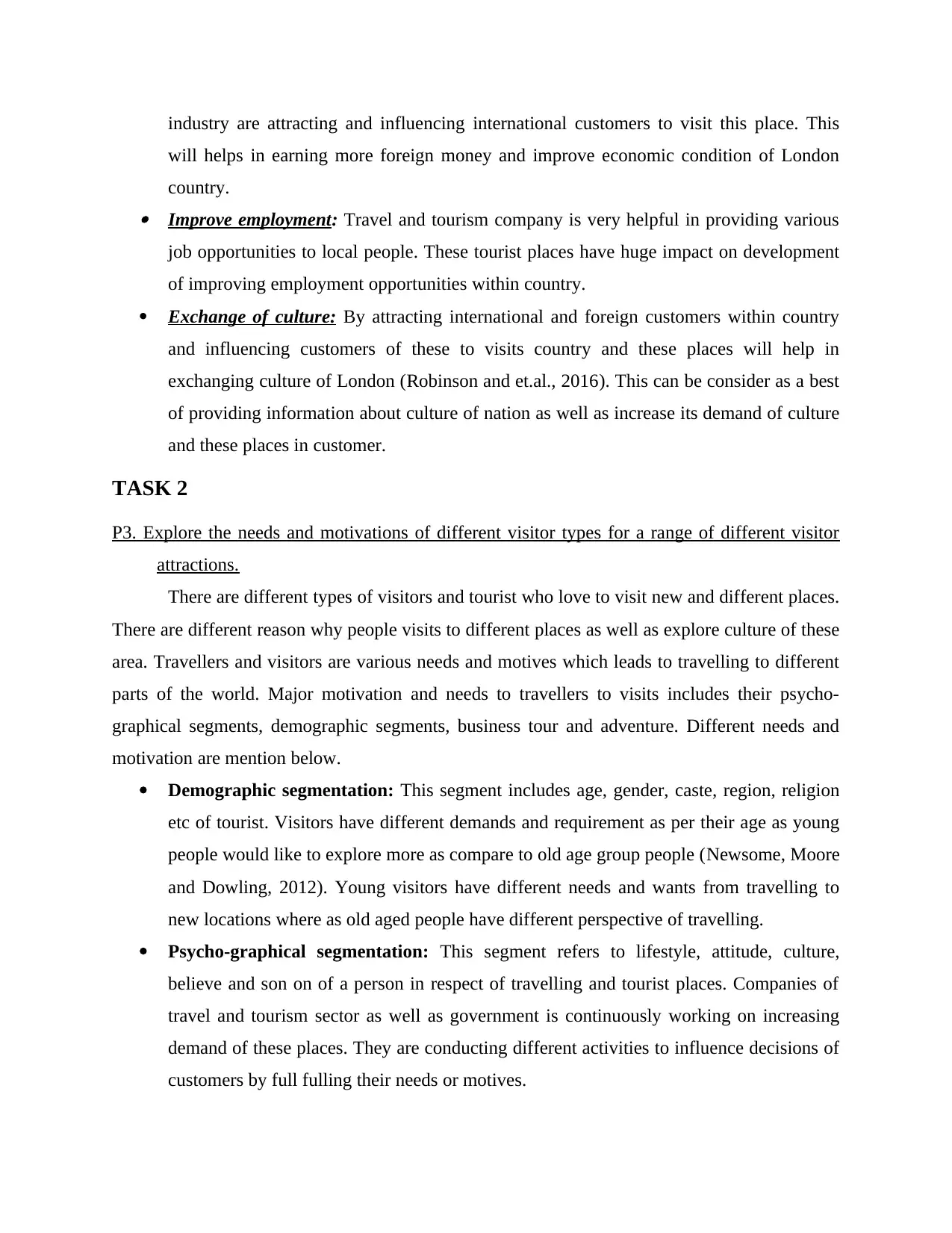
industry are attracting and influencing international customers to visit this place. This
will helps in earning more foreign money and improve economic condition of London
country. Improve employment: Travel and tourism company is very helpful in providing various
job opportunities to local people. These tourist places have huge impact on development
of improving employment opportunities within country.
Exchange of culture: By attracting international and foreign customers within country
and influencing customers of these to visits country and these places will help in
exchanging culture of London (Robinson and et.al., 2016). This can be consider as a best
of providing information about culture of nation as well as increase its demand of culture
and these places in customer.
TASK 2
P3. Explore the needs and motivations of different visitor types for a range of different visitor
attractions.
There are different types of visitors and tourist who love to visit new and different places.
There are different reason why people visits to different places as well as explore culture of these
area. Travellers and visitors are various needs and motives which leads to travelling to different
parts of the world. Major motivation and needs to travellers to visits includes their psycho-
graphical segments, demographic segments, business tour and adventure. Different needs and
motivation are mention below.
Demographic segmentation: This segment includes age, gender, caste, region, religion
etc of tourist. Visitors have different demands and requirement as per their age as young
people would like to explore more as compare to old age group people (Newsome, Moore
and Dowling, 2012). Young visitors have different needs and wants from travelling to
new locations where as old aged people have different perspective of travelling.
Psycho-graphical segmentation: This segment refers to lifestyle, attitude, culture,
believe and son on of a person in respect of travelling and tourist places. Companies of
travel and tourism sector as well as government is continuously working on increasing
demand of these places. They are conducting different activities to influence decisions of
customers by full fulling their needs or motives.
will helps in earning more foreign money and improve economic condition of London
country. Improve employment: Travel and tourism company is very helpful in providing various
job opportunities to local people. These tourist places have huge impact on development
of improving employment opportunities within country.
Exchange of culture: By attracting international and foreign customers within country
and influencing customers of these to visits country and these places will help in
exchanging culture of London (Robinson and et.al., 2016). This can be consider as a best
of providing information about culture of nation as well as increase its demand of culture
and these places in customer.
TASK 2
P3. Explore the needs and motivations of different visitor types for a range of different visitor
attractions.
There are different types of visitors and tourist who love to visit new and different places.
There are different reason why people visits to different places as well as explore culture of these
area. Travellers and visitors are various needs and motives which leads to travelling to different
parts of the world. Major motivation and needs to travellers to visits includes their psycho-
graphical segments, demographic segments, business tour and adventure. Different needs and
motivation are mention below.
Demographic segmentation: This segment includes age, gender, caste, region, religion
etc of tourist. Visitors have different demands and requirement as per their age as young
people would like to explore more as compare to old age group people (Newsome, Moore
and Dowling, 2012). Young visitors have different needs and wants from travelling to
new locations where as old aged people have different perspective of travelling.
Psycho-graphical segmentation: This segment refers to lifestyle, attitude, culture,
believe and son on of a person in respect of travelling and tourist places. Companies of
travel and tourism sector as well as government is continuously working on increasing
demand of these places. They are conducting different activities to influence decisions of
customers by full fulling their needs or motives.
Paraphrase This Document
Need a fresh take? Get an instant paraphrase of this document with our AI Paraphraser
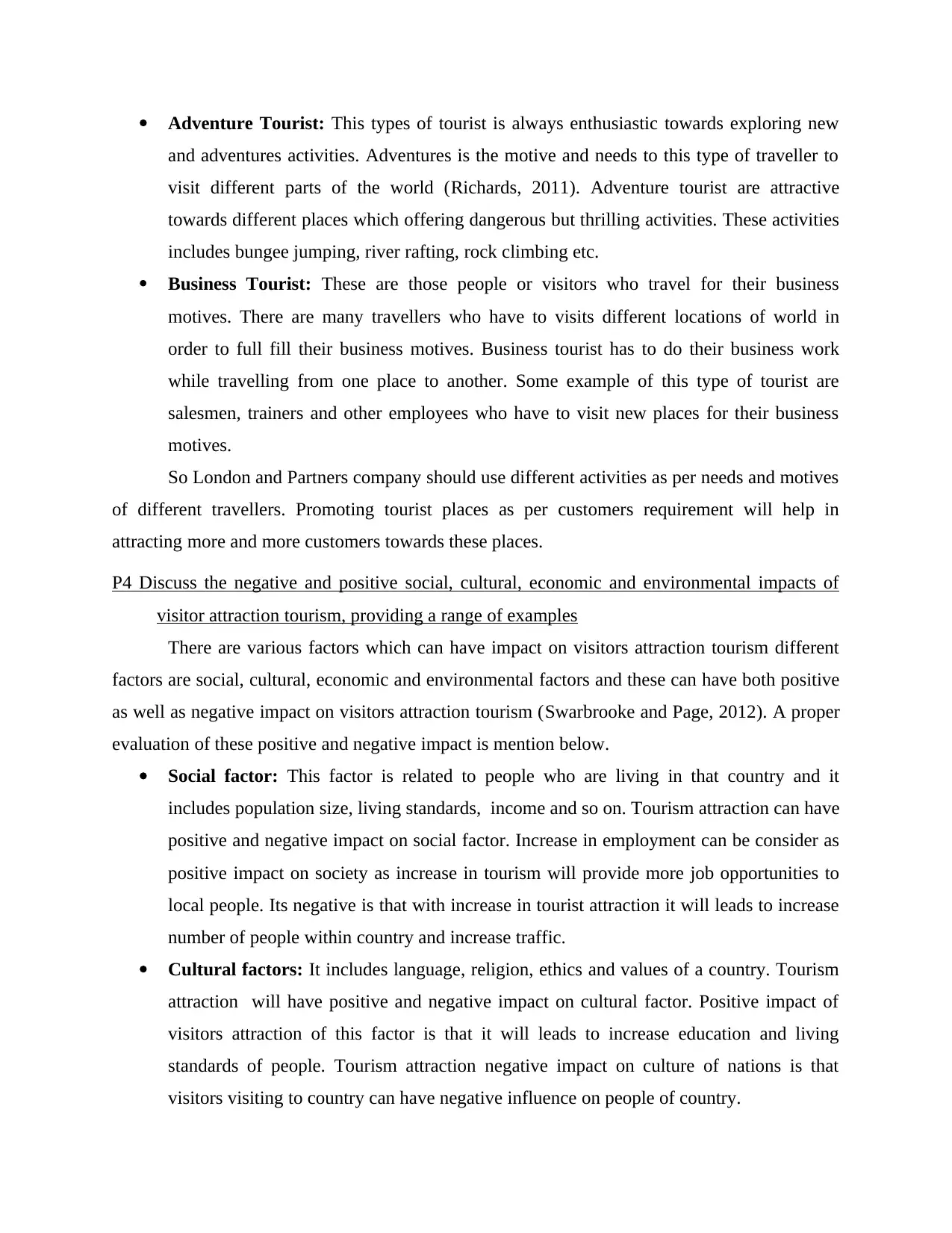
Adventure Tourist: This types of tourist is always enthusiastic towards exploring new
and adventures activities. Adventures is the motive and needs to this type of traveller to
visit different parts of the world (Richards, 2011). Adventure tourist are attractive
towards different places which offering dangerous but thrilling activities. These activities
includes bungee jumping, river rafting, rock climbing etc.
Business Tourist: These are those people or visitors who travel for their business
motives. There are many travellers who have to visits different locations of world in
order to full fill their business motives. Business tourist has to do their business work
while travelling from one place to another. Some example of this type of tourist are
salesmen, trainers and other employees who have to visit new places for their business
motives.
So London and Partners company should use different activities as per needs and motives
of different travellers. Promoting tourist places as per customers requirement will help in
attracting more and more customers towards these places.
P4 Discuss the negative and positive social, cultural, economic and environmental impacts of
visitor attraction tourism, providing a range of examples
There are various factors which can have impact on visitors attraction tourism different
factors are social, cultural, economic and environmental factors and these can have both positive
as well as negative impact on visitors attraction tourism (Swarbrooke and Page, 2012). A proper
evaluation of these positive and negative impact is mention below.
Social factor: This factor is related to people who are living in that country and it
includes population size, living standards, income and so on. Tourism attraction can have
positive and negative impact on social factor. Increase in employment can be consider as
positive impact on society as increase in tourism will provide more job opportunities to
local people. Its negative is that with increase in tourist attraction it will leads to increase
number of people within country and increase traffic.
Cultural factors: It includes language, religion, ethics and values of a country. Tourism
attraction will have positive and negative impact on cultural factor. Positive impact of
visitors attraction of this factor is that it will leads to increase education and living
standards of people. Tourism attraction negative impact on culture of nations is that
visitors visiting to country can have negative influence on people of country.
and adventures activities. Adventures is the motive and needs to this type of traveller to
visit different parts of the world (Richards, 2011). Adventure tourist are attractive
towards different places which offering dangerous but thrilling activities. These activities
includes bungee jumping, river rafting, rock climbing etc.
Business Tourist: These are those people or visitors who travel for their business
motives. There are many travellers who have to visits different locations of world in
order to full fill their business motives. Business tourist has to do their business work
while travelling from one place to another. Some example of this type of tourist are
salesmen, trainers and other employees who have to visit new places for their business
motives.
So London and Partners company should use different activities as per needs and motives
of different travellers. Promoting tourist places as per customers requirement will help in
attracting more and more customers towards these places.
P4 Discuss the negative and positive social, cultural, economic and environmental impacts of
visitor attraction tourism, providing a range of examples
There are various factors which can have impact on visitors attraction tourism different
factors are social, cultural, economic and environmental factors and these can have both positive
as well as negative impact on visitors attraction tourism (Swarbrooke and Page, 2012). A proper
evaluation of these positive and negative impact is mention below.
Social factor: This factor is related to people who are living in that country and it
includes population size, living standards, income and so on. Tourism attraction can have
positive and negative impact on social factor. Increase in employment can be consider as
positive impact on society as increase in tourism will provide more job opportunities to
local people. Its negative is that with increase in tourist attraction it will leads to increase
number of people within country and increase traffic.
Cultural factors: It includes language, religion, ethics and values of a country. Tourism
attraction will have positive and negative impact on cultural factor. Positive impact of
visitors attraction of this factor is that it will leads to increase education and living
standards of people. Tourism attraction negative impact on culture of nations is that
visitors visiting to country can have negative influence on people of country.
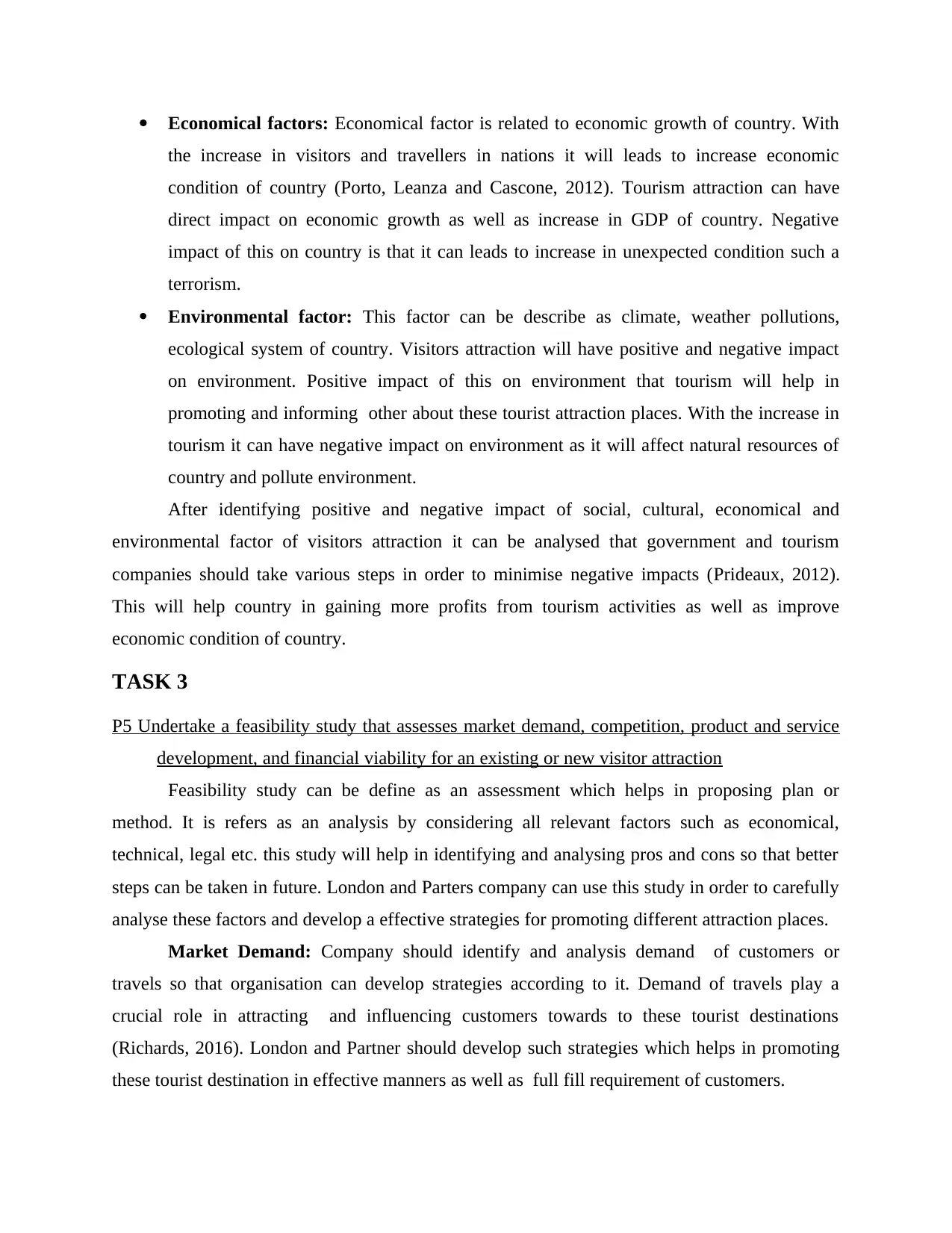
Economical factors: Economical factor is related to economic growth of country. With
the increase in visitors and travellers in nations it will leads to increase economic
condition of country (Porto, Leanza and Cascone, 2012). Tourism attraction can have
direct impact on economic growth as well as increase in GDP of country. Negative
impact of this on country is that it can leads to increase in unexpected condition such a
terrorism.
Environmental factor: This factor can be describe as climate, weather pollutions,
ecological system of country. Visitors attraction will have positive and negative impact
on environment. Positive impact of this on environment that tourism will help in
promoting and informing other about these tourist attraction places. With the increase in
tourism it can have negative impact on environment as it will affect natural resources of
country and pollute environment.
After identifying positive and negative impact of social, cultural, economical and
environmental factor of visitors attraction it can be analysed that government and tourism
companies should take various steps in order to minimise negative impacts (Prideaux, 2012).
This will help country in gaining more profits from tourism activities as well as improve
economic condition of country.
TASK 3
P5 Undertake a feasibility study that assesses market demand, competition, product and service
development, and financial viability for an existing or new visitor attraction
Feasibility study can be define as an assessment which helps in proposing plan or
method. It is refers as an analysis by considering all relevant factors such as economical,
technical, legal etc. this study will help in identifying and analysing pros and cons so that better
steps can be taken in future. London and Parters company can use this study in order to carefully
analyse these factors and develop a effective strategies for promoting different attraction places.
Market Demand: Company should identify and analysis demand of customers or
travels so that organisation can develop strategies according to it. Demand of travels play a
crucial role in attracting and influencing customers towards to these tourist destinations
(Richards, 2016). London and Partner should develop such strategies which helps in promoting
these tourist destination in effective manners as well as full fill requirement of customers.
the increase in visitors and travellers in nations it will leads to increase economic
condition of country (Porto, Leanza and Cascone, 2012). Tourism attraction can have
direct impact on economic growth as well as increase in GDP of country. Negative
impact of this on country is that it can leads to increase in unexpected condition such a
terrorism.
Environmental factor: This factor can be describe as climate, weather pollutions,
ecological system of country. Visitors attraction will have positive and negative impact
on environment. Positive impact of this on environment that tourism will help in
promoting and informing other about these tourist attraction places. With the increase in
tourism it can have negative impact on environment as it will affect natural resources of
country and pollute environment.
After identifying positive and negative impact of social, cultural, economical and
environmental factor of visitors attraction it can be analysed that government and tourism
companies should take various steps in order to minimise negative impacts (Prideaux, 2012).
This will help country in gaining more profits from tourism activities as well as improve
economic condition of country.
TASK 3
P5 Undertake a feasibility study that assesses market demand, competition, product and service
development, and financial viability for an existing or new visitor attraction
Feasibility study can be define as an assessment which helps in proposing plan or
method. It is refers as an analysis by considering all relevant factors such as economical,
technical, legal etc. this study will help in identifying and analysing pros and cons so that better
steps can be taken in future. London and Parters company can use this study in order to carefully
analyse these factors and develop a effective strategies for promoting different attraction places.
Market Demand: Company should identify and analysis demand of customers or
travels so that organisation can develop strategies according to it. Demand of travels play a
crucial role in attracting and influencing customers towards to these tourist destinations
(Richards, 2016). London and Partner should develop such strategies which helps in promoting
these tourist destination in effective manners as well as full fill requirement of customers.
⊘ This is a preview!⊘
Do you want full access?
Subscribe today to unlock all pages.

Trusted by 1+ million students worldwide
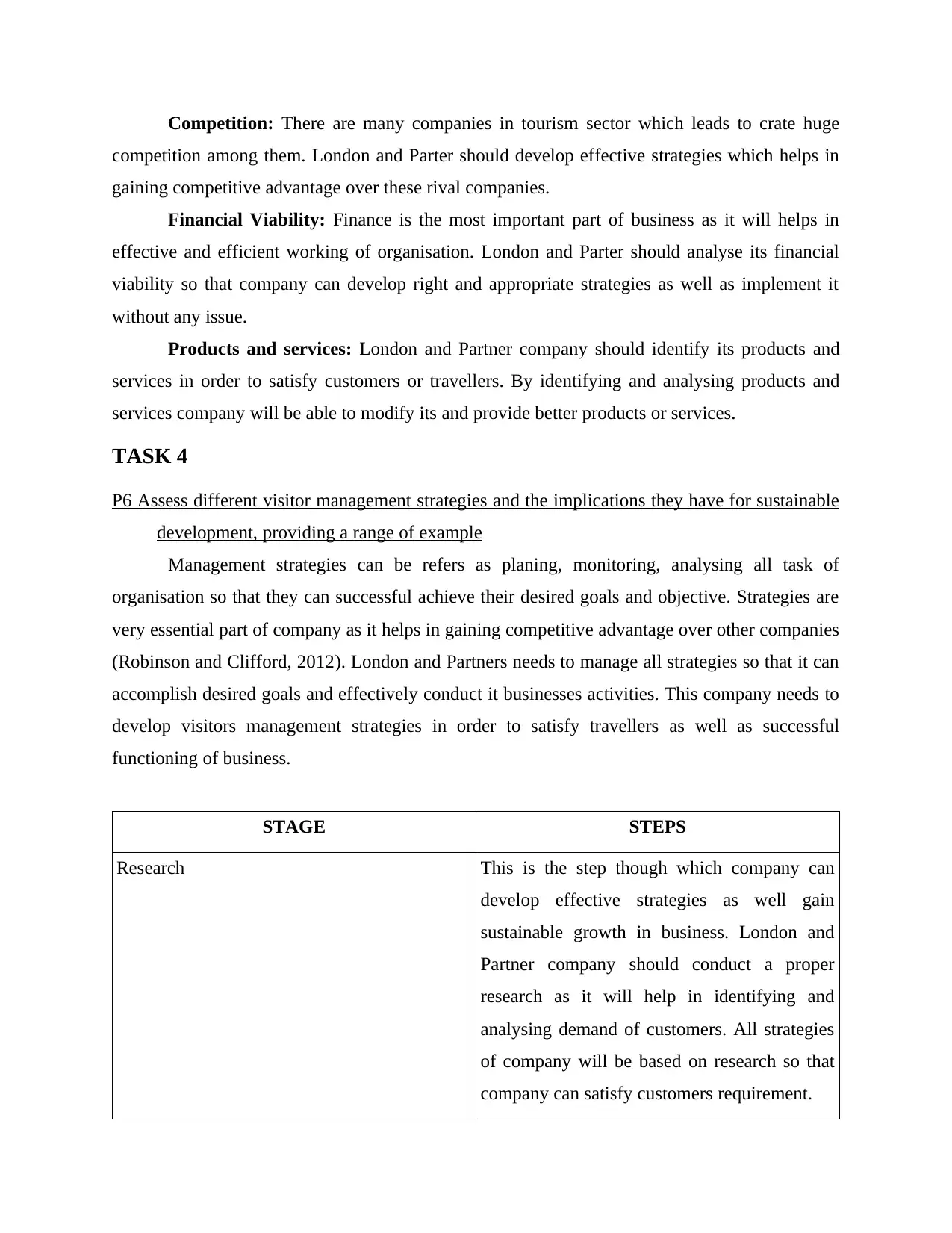
Competition: There are many companies in tourism sector which leads to crate huge
competition among them. London and Parter should develop effective strategies which helps in
gaining competitive advantage over these rival companies.
Financial Viability: Finance is the most important part of business as it will helps in
effective and efficient working of organisation. London and Parter should analyse its financial
viability so that company can develop right and appropriate strategies as well as implement it
without any issue.
Products and services: London and Partner company should identify its products and
services in order to satisfy customers or travellers. By identifying and analysing products and
services company will be able to modify its and provide better products or services.
TASK 4
P6 Assess different visitor management strategies and the implications they have for sustainable
development, providing a range of example
Management strategies can be refers as planing, monitoring, analysing all task of
organisation so that they can successful achieve their desired goals and objective. Strategies are
very essential part of company as it helps in gaining competitive advantage over other companies
(Robinson and Clifford, 2012). London and Partners needs to manage all strategies so that it can
accomplish desired goals and effectively conduct it businesses activities. This company needs to
develop visitors management strategies in order to satisfy travellers as well as successful
functioning of business.
STAGE STEPS
Research This is the step though which company can
develop effective strategies as well gain
sustainable growth in business. London and
Partner company should conduct a proper
research as it will help in identifying and
analysing demand of customers. All strategies
of company will be based on research so that
company can satisfy customers requirement.
competition among them. London and Parter should develop effective strategies which helps in
gaining competitive advantage over these rival companies.
Financial Viability: Finance is the most important part of business as it will helps in
effective and efficient working of organisation. London and Parter should analyse its financial
viability so that company can develop right and appropriate strategies as well as implement it
without any issue.
Products and services: London and Partner company should identify its products and
services in order to satisfy customers or travellers. By identifying and analysing products and
services company will be able to modify its and provide better products or services.
TASK 4
P6 Assess different visitor management strategies and the implications they have for sustainable
development, providing a range of example
Management strategies can be refers as planing, monitoring, analysing all task of
organisation so that they can successful achieve their desired goals and objective. Strategies are
very essential part of company as it helps in gaining competitive advantage over other companies
(Robinson and Clifford, 2012). London and Partners needs to manage all strategies so that it can
accomplish desired goals and effectively conduct it businesses activities. This company needs to
develop visitors management strategies in order to satisfy travellers as well as successful
functioning of business.
STAGE STEPS
Research This is the step though which company can
develop effective strategies as well gain
sustainable growth in business. London and
Partner company should conduct a proper
research as it will help in identifying and
analysing demand of customers. All strategies
of company will be based on research so that
company can satisfy customers requirement.
Paraphrase This Document
Need a fresh take? Get an instant paraphrase of this document with our AI Paraphraser
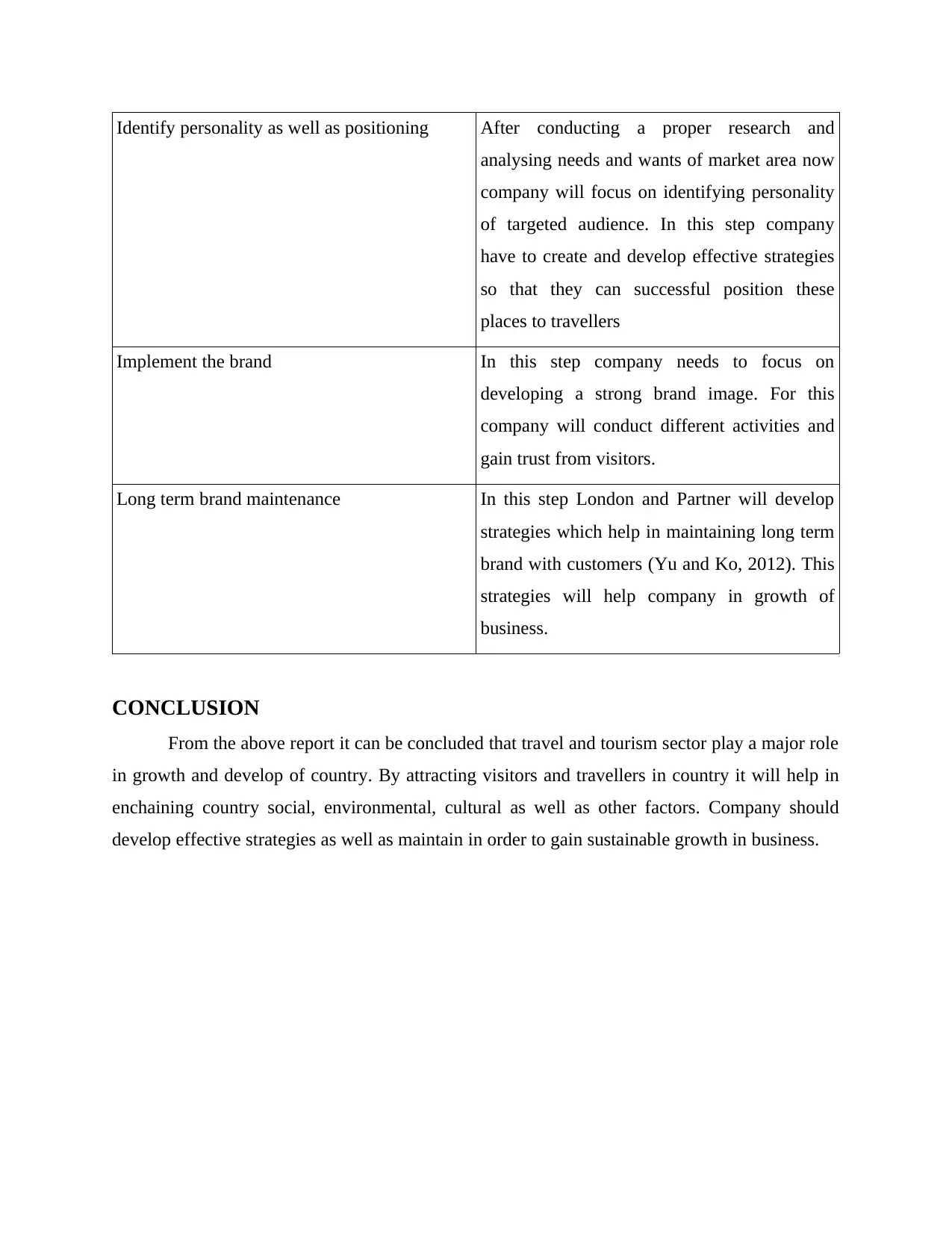
Identify personality as well as positioning After conducting a proper research and
analysing needs and wants of market area now
company will focus on identifying personality
of targeted audience. In this step company
have to create and develop effective strategies
so that they can successful position these
places to travellers
Implement the brand In this step company needs to focus on
developing a strong brand image. For this
company will conduct different activities and
gain trust from visitors.
Long term brand maintenance In this step London and Partner will develop
strategies which help in maintaining long term
brand with customers (Yu and Ko, 2012). This
strategies will help company in growth of
business.
CONCLUSION
From the above report it can be concluded that travel and tourism sector play a major role
in growth and develop of country. By attracting visitors and travellers in country it will help in
enchaining country social, environmental, cultural as well as other factors. Company should
develop effective strategies as well as maintain in order to gain sustainable growth in business.
analysing needs and wants of market area now
company will focus on identifying personality
of targeted audience. In this step company
have to create and develop effective strategies
so that they can successful position these
places to travellers
Implement the brand In this step company needs to focus on
developing a strong brand image. For this
company will conduct different activities and
gain trust from visitors.
Long term brand maintenance In this step London and Partner will develop
strategies which help in maintaining long term
brand with customers (Yu and Ko, 2012). This
strategies will help company in growth of
business.
CONCLUSION
From the above report it can be concluded that travel and tourism sector play a major role
in growth and develop of country. By attracting visitors and travellers in country it will help in
enchaining country social, environmental, cultural as well as other factors. Company should
develop effective strategies as well as maintain in order to gain sustainable growth in business.
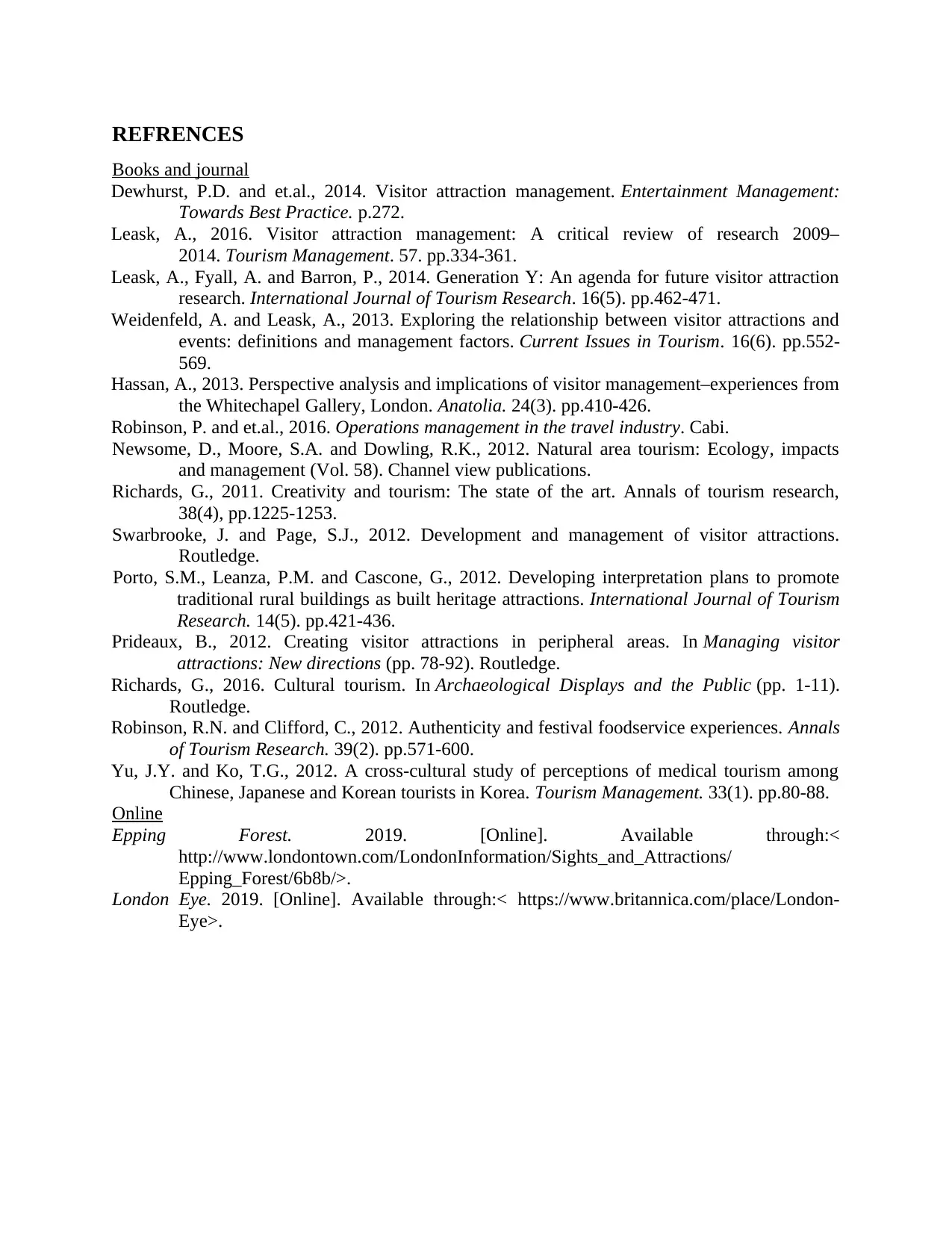
REFRENCES
Books and journal
Dewhurst, P.D. and et.al., 2014. Visitor attraction management. Entertainment Management:
Towards Best Practice. p.272.
Leask, A., 2016. Visitor attraction management: A critical review of research 2009–
2014. Tourism Management. 57. pp.334-361.
Leask, A., Fyall, A. and Barron, P., 2014. Generation Y: An agenda for future visitor attraction
research. International Journal of Tourism Research. 16(5). pp.462-471.
Weidenfeld, A. and Leask, A., 2013. Exploring the relationship between visitor attractions and
events: definitions and management factors. Current Issues in Tourism. 16(6). pp.552-
569.
Hassan, A., 2013. Perspective analysis and implications of visitor management–experiences from
the Whitechapel Gallery, London. Anatolia. 24(3). pp.410-426.
Robinson, P. and et.al., 2016. Operations management in the travel industry. Cabi.
Newsome, D., Moore, S.A. and Dowling, R.K., 2012. Natural area tourism: Ecology, impacts
and management (Vol. 58). Channel view publications.
Richards, G., 2011. Creativity and tourism: The state of the art. Annals of tourism research,
38(4), pp.1225-1253.
Swarbrooke, J. and Page, S.J., 2012. Development and management of visitor attractions.
Routledge.
Porto, S.M., Leanza, P.M. and Cascone, G., 2012. Developing interpretation plans to promote
traditional rural buildings as built heritage attractions. International Journal of Tourism
Research. 14(5). pp.421-436.
Prideaux, B., 2012. Creating visitor attractions in peripheral areas. In Managing visitor
attractions: New directions (pp. 78-92). Routledge.
Richards, G., 2016. Cultural tourism. In Archaeological Displays and the Public (pp. 1-11).
Routledge.
Robinson, R.N. and Clifford, C., 2012. Authenticity and festival foodservice experiences. Annals
of Tourism Research. 39(2). pp.571-600.
Yu, J.Y. and Ko, T.G., 2012. A cross-cultural study of perceptions of medical tourism among
Chinese, Japanese and Korean tourists in Korea. Tourism Management. 33(1). pp.80-88.
Online
Epping Forest. 2019. [Online]. Available through:<
http://www.londontown.com/LondonInformation/Sights_and_Attractions/
Epping_Forest/6b8b/>.
London Eye. 2019. [Online]. Available through:< https://www.britannica.com/place/London-
Eye>.
Books and journal
Dewhurst, P.D. and et.al., 2014. Visitor attraction management. Entertainment Management:
Towards Best Practice. p.272.
Leask, A., 2016. Visitor attraction management: A critical review of research 2009–
2014. Tourism Management. 57. pp.334-361.
Leask, A., Fyall, A. and Barron, P., 2014. Generation Y: An agenda for future visitor attraction
research. International Journal of Tourism Research. 16(5). pp.462-471.
Weidenfeld, A. and Leask, A., 2013. Exploring the relationship between visitor attractions and
events: definitions and management factors. Current Issues in Tourism. 16(6). pp.552-
569.
Hassan, A., 2013. Perspective analysis and implications of visitor management–experiences from
the Whitechapel Gallery, London. Anatolia. 24(3). pp.410-426.
Robinson, P. and et.al., 2016. Operations management in the travel industry. Cabi.
Newsome, D., Moore, S.A. and Dowling, R.K., 2012. Natural area tourism: Ecology, impacts
and management (Vol. 58). Channel view publications.
Richards, G., 2011. Creativity and tourism: The state of the art. Annals of tourism research,
38(4), pp.1225-1253.
Swarbrooke, J. and Page, S.J., 2012. Development and management of visitor attractions.
Routledge.
Porto, S.M., Leanza, P.M. and Cascone, G., 2012. Developing interpretation plans to promote
traditional rural buildings as built heritage attractions. International Journal of Tourism
Research. 14(5). pp.421-436.
Prideaux, B., 2012. Creating visitor attractions in peripheral areas. In Managing visitor
attractions: New directions (pp. 78-92). Routledge.
Richards, G., 2016. Cultural tourism. In Archaeological Displays and the Public (pp. 1-11).
Routledge.
Robinson, R.N. and Clifford, C., 2012. Authenticity and festival foodservice experiences. Annals
of Tourism Research. 39(2). pp.571-600.
Yu, J.Y. and Ko, T.G., 2012. A cross-cultural study of perceptions of medical tourism among
Chinese, Japanese and Korean tourists in Korea. Tourism Management. 33(1). pp.80-88.
Online
Epping Forest. 2019. [Online]. Available through:<
http://www.londontown.com/LondonInformation/Sights_and_Attractions/
Epping_Forest/6b8b/>.
London Eye. 2019. [Online]. Available through:< https://www.britannica.com/place/London-
Eye>.
⊘ This is a preview!⊘
Do you want full access?
Subscribe today to unlock all pages.

Trusted by 1+ million students worldwide
1 out of 12
Related Documents
Your All-in-One AI-Powered Toolkit for Academic Success.
+13062052269
info@desklib.com
Available 24*7 on WhatsApp / Email
![[object Object]](/_next/static/media/star-bottom.7253800d.svg)
Unlock your academic potential
Copyright © 2020–2025 A2Z Services. All Rights Reserved. Developed and managed by ZUCOL.





